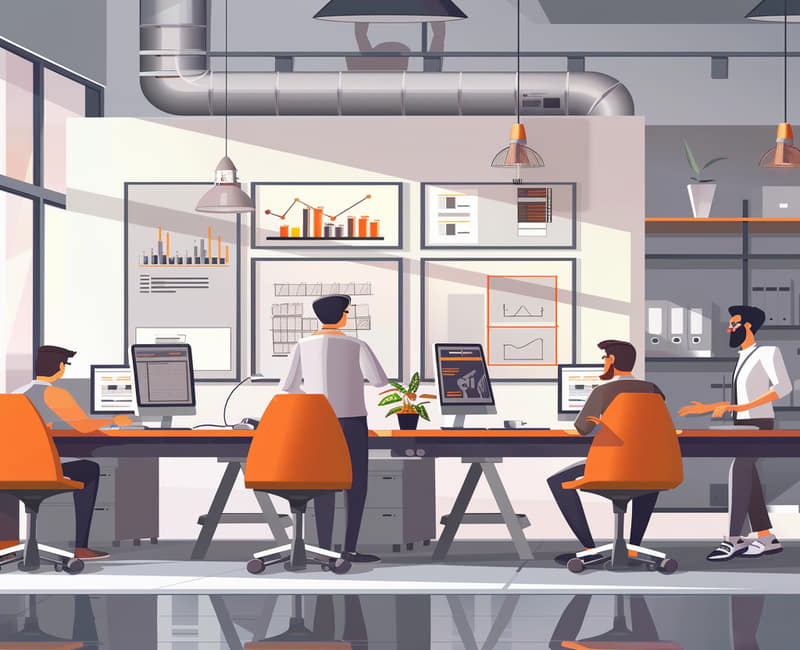TOGAF Training | Learn TOGAF Course
About TOGAF
TOGAF, or The Open Group Architecture Framework, provides an intriguing insight into IT architecture where ideals and reality meet to produce a blueprint for organizational transformation.
Consider TOGAF an exciting journey across the high seas of technology, where each wave represents an individual challenge and points you towards success and innovation.
TOGAF serves as your trusted navigator by offering maps, tools and advice that help guide your path across uncharted IT waters.
TOGAF’s flexible and adaptive approach helps firms navigate turbulent waters while keeping an eye on long-term goals while remaining flexible to change.
With TOGAF as their tool of navigation, IT leaders can become bold captains on digital expeditions.
Discoveringuncharted territories while surmounting challenges within IT landscapes to lead enterprises into greater levels of innovation and success. Here are just a few benefits TOGAF can bring.

Benefits of TOGAF
The benefits of TOGAF, The Open Group Architecture Framework, are as numerous and varied as the businesses who use it.
Here are some of the primary benefits that make TOGAF a vital tool for IT leaders:
Standardization: TOGAF can help businesses communicate efficiently and align efforts on shared goals more easily.
Modularity: With its modular approach enabling organizations to tackle IT problems one piece at a time, keeping a clear view of the big picture while making sure solutions seamlessly mesh together.
Flexibility: TOGAF’s agile and adaptable methodology gives organizations the power to respond rapidly to changing business requirements and technical developments while aligning IT infrastructures with strategic goals.
Reusability: TOGAF’s collection of architectural building blocks and best practices allow businesses to repurpose proven solutions, saving both time-to-market and risk of recreating solutions from scratch.
Governance: With TOGAF as their guide for IT governance, businesses have an easy and uniform means for managing IT effectively and making strategic business decisions without reinventing solutions from scratch.
Collaboration: TOGAF facilitates collaboration among all stakeholders as it encourages knowledge exchange among members allowing companies to overcome siloed approaches towards meeting common goals more easily.
Continuous Improvement: TOGAF’s iterative architecture creation method enables firms to continuously refine their IT architecture in accordance with changing business needs and trends, guaranteeing compliance.
Overall, TOGAF has an effective and practical framework for IT architecture that aids organizations in designing effective, efficient IT landscapes that support strategic goals and facilitate commercial success.
Prerequisites of TOGAF
Organizations and people seeking the maximum value from using TOGAF, The Open Group Architecture Framework, should keep these items in mind:
Understanding of Business Objectives: TOGAF serves primarily as a bridge between IT resources and company goals and goals of an enterprise, making for more strategic use.
Understanding of Business Objectives: Understanding business goals and using this knowledge to structure an IT infrastructure that supports them are both key steps towards successful IT governance.
IT Knowledge and competence: TOGAF requires possessing strong technical know-how and competency, making this standard essential in successful project governance.
Organizational Support: TOGAF is a collaborative project, necessitating participation from various stakeholder within an organization’s IT, business, and executive management as well as other constituents such as users. For this to be effective and sustainable over time.
Time and Resources: Implementation of TOGAF requires significant investments of time and resources, which includes learning the framework, planning an architecture development process, and maintaining and supporting it over time.
Agility and Flexibility: TOGAF takes an iterative and adaptive approach to IT architecture, and requires organizations to be ready and capable of adapting quickly in response to changing business needs and technology trends, adapting their IT architecture accordingly.
Governance and Compliance: TOGAF provides an effective methodology for IT governance; however, organizations should commit to adopting, enforcing and monitoring TOGAF controls in order to ensure their IT architecture aligns with strategic goals while meeting regulatory compliance.
Businesses and individuals alike can utilize TOGAF effectively by meeting these criteria to design, construct, and sustain effective IT landscapes that support strategic goals for commercial success and promote lasting benefits for them and their stakeholders.

TOGAF Training

TOGAF Tutorial
TOGAF: A Foundation for Enterprise Architecture
TOGAF was developed by over 300 Architecture Forum member businesses as an architecture development framework, featuring tools, a common vocabulary, an approach for structuring enterprise states in building blocks, as well as standards and complying goods lists.
TOGAF provides consistent solutions that address stakeholder interests while meeting current and anticipated company needs. By standardizing architecture development risk reduction practices and helping organizations design economically-sound solutions.
TOGAF’s ADM guidelines and procedures, Architecture Content Framework, Enterprise Continuum, TOGAF Reference Models and Capability Framework each highlight business goals as driving forces behind architecture development; while also offering best practices.
Together these components help speed and ease up architectural creation while covering every corner of project implementation.
TOGAF, the popular business architecture framework, provides an iterative method for planning, creating, implementing and regulating architecture with tools and reference models available at its fingertips.
The Architecture Development Method (ADM): An Iterative Approach to Enterprise Architecture
The Architecture Development Method (ADM) is an iterative sequence of steps used to develop enterprise architecture. This includes guidelines and techniques found within an Architecture Content Model document that are provided.
ADM uses three reference models; Aspire Framework, Enterprise Continuum and TOGAF reference models are iterative with each phase being validated against current business needs and validated against each phase prior to being passed onto subsequent phases.

Road Mapping: An Organizational Tool to Provide Direction and Risk Management
Road mapping has long been used by organizations including universities, finance, and non-profits as an efficient means to maintain risk management practices and guide strategic direction. Road maps may also serve different functions within organizations.
Forinstance identifying problem areas within processes or providing visual direction on where resources need to go for various goals and projects.
The Importance of Meta Model in Roadmaps
TOGAF has an effective framework for producing roadmaps and applying them. The metamodel, comprised of components, objects and relationships among these objects is crucial in building roadmaps that cover different technologies or business areas; technology roadmaps typically utilize elements from this meta model as do product roadmaps and business ones.
Mastering Roadmap Creation and Implementation
Road mapping helps organizations manage risk and provide direction. Successful roadmapsrequire experience as well as access to an experienced community with shared resources and expertise.
A roadmap allows businesses to track initiatives over time as defined by TOGAF (The Open Group Architecture Framework).
People, processes and technology all experience change over time; therefore, technology and architecture roadmaps form subsets of an architectural landscape.
Roadmaps often consist of four styles of maps: tagging, traditional time aspect, model links and numerous links between elements on them.

TOGAF Online Training

Modes of learning TOGAF
The Open Group Architecture Framework (TOGAF) can be taught in a variety of ways to suit different learning styles. There are two prominent TOGAF learning methods:
Instructor-taught Live Training: Participants engage in interactive activities, group discussions and hands-on exercises designed to teach TOGAF best practices during an instructor-led live training session.
For optimal learning of these frameworks, real time feedback and instructor supervision provide real time response capabilities and feedback loops.
Self-Paced Training: Take TOGAF training modules at your own pace online at any time and pace yourself through them at your convenience, making this option suitable for both traditional and collaborative learners.
It offers flexibility as it doesn’t depend on an instructor for guidance. Ultimately it provides learners with both traditional and collaborative learners an effective training experience.
Instructor-led live and self-paced have their own benefits; making these decisions ultimately up to each learner themselves.
It may also make more sense depending on time or travel constraints – both have pros and cons which must be carefully considered when making decisions regarding which will work better for their specific situation. Choosing one over another depends entirely upon individual preference.

TOGAF Certification
To comprehend the roles and duties of personnel with each of the TOGAF certifications you specified.
TOGAF 9 Foundation: A person with this certification has a fundamental understanding of the TOGAF 9 Architecture Development Method (ADM) and its major concepts, words, and models.
They may not have practical experience with TOGAF 9, but they have a good foundation of knowledge on which to build.
TOGAF 9 Certified (or TOGAF 9 Practitioner): A person with this credential has developed practical expertise using the TOGAF 9 ADM to design, plan, implement, and control corporate architectures.
They can use TOGAF 9 to describe architecture content, build architecture artifacts, and follow the ADM phases.
TOGAF Enterprise Architecture Foundation: This certification is specifically for the role of Enterprise Architect. A person with this certification has a thorough understanding of the enterprise architecture function, including the skills and knowledge needed to design, develop, implement, and govern enterprise architectures.
TOGAF Enterprise Architecture Practitioner: This certification expands on the Enterprise Architecture Foundation certification by validating the individual’s ability to apply enterprise architecture concepts and practices in a real-world setting.
They can develop and implement enterprise architectures using TOGAF 9, as well as lead and mentor others in their use of the framework.
It’s crucial to remember that these certificates build on one another, with the Foundation certifications giving a strong foundation of knowledge and the Practitioner and Architect certifications certifying practical experience and skill.
Finally, TOGAF (The Open Group Architecture Framework) is a popular business architecture framework that offers a standardized way to designing, planning, executing, and managing enterprise architectures.
The certifications are TOGAF 9 Foundation, TOGAF 9 Certified (Practitioner), TOGAF Enterprise Architecture Foundation, TOGAF Enterprise Architecture Practitioner,
Each certification builds on the preceding one, beginning with a basic understanding of TOGAF and continuing to hands-on experience and skill in enterprise architecture design and deployment.

TOGAF Course Price


Saniya
Author